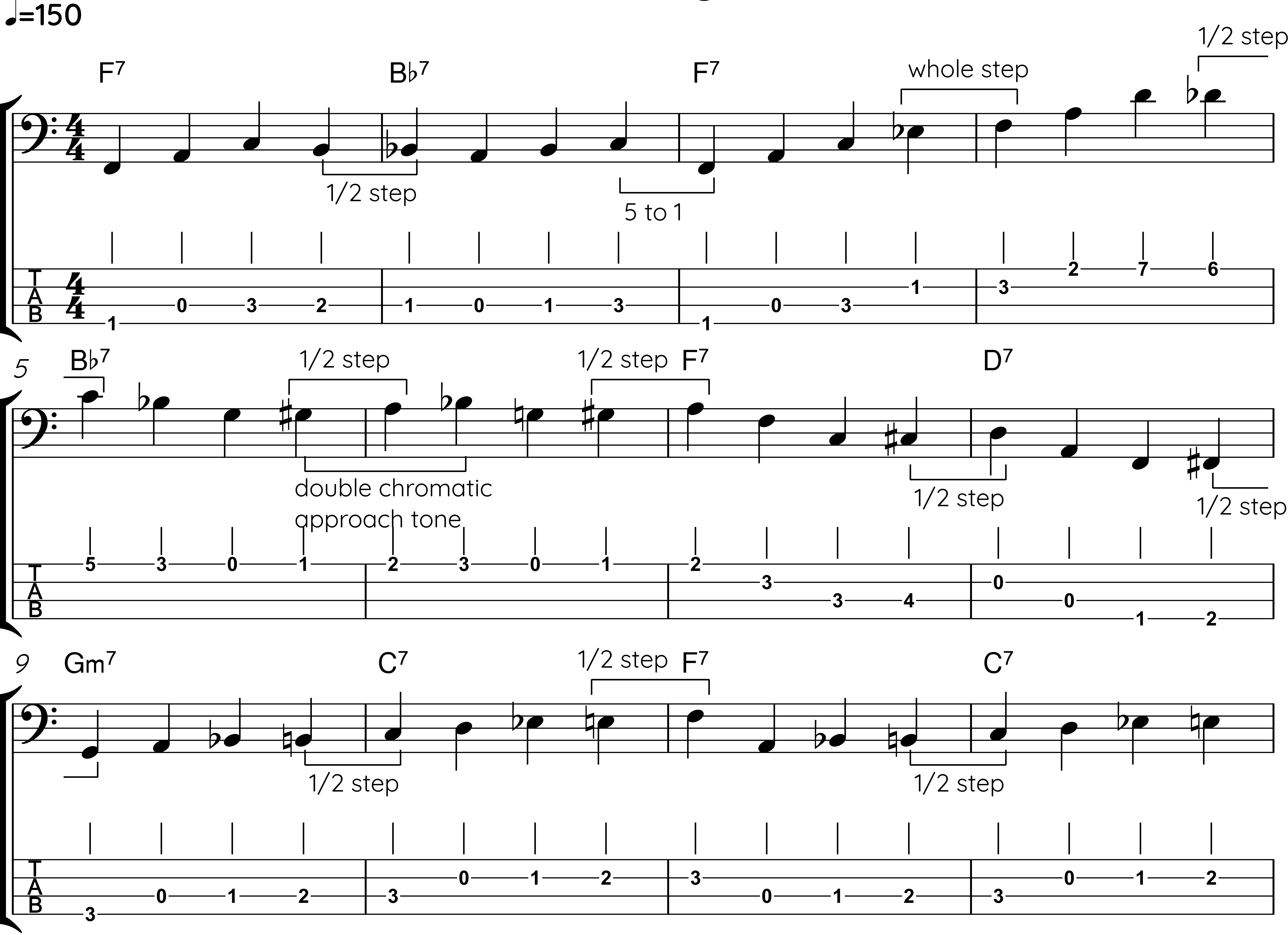This Route 66 walking bass line uses a lot of chromatic-ism in it. Half step, double chromatic approach, triple chromatic approach… they are all in there, plus 5 to 1 resolutions, enclosures, and some rhythmic development.
A good walking bass line will perform its basic function (set good time and outline harmony) and will be musical with a clear direction. You should hear some themes or ideas in this bass line as you play through it and hopefully it will give you some ideas that you can use in your playing.
What we are going to do in this article is analyze just the first 12 bars of this bass line. I find that transcribing and analyzing really helps me to internalize new ideas.
We will be analyzing three different elements.
- Chord and Scale Tone Analysis
- Approach Tones Analysis
- Common Walking Bass Line Figures
Route 66 Walking Bass Line Chord & Scale Tone Analysis
When you are doing this analysis the first thing you want to do is go through and just write out each chord or scale tone. When you get to a note that is not part of the chord or scale tones you won’t label those, just focus on the chord and scale tones.

Route 66 Walking Bass Line Non-Chord & Scale Tone Analysis
The next part of the analysis takes a couple of steps to finish so here is the process.
- Go through and circle all the notes that aren’t in the Chord or Scale Tones
- Label each of the circle notes with the type of approach it is… 1/2 step, perfect 5th, enclosure, etc.
- Mark the direction that the note resolves to… just up or down here
Here’s what it would look like after you finish that step.

After you have done this you will want to look everything over and see if you notice any patterns or things that jump out to you.
I noticed In this example all of the notes that are not coming from the chord or scale tone are just half steps below or above the next note. This half step root movement is a very powerful resolution.
Does anything else jump out to you?
Route 66 Walking Bass Line Approach Tones Analysis
The notes that we are concerned about in this analysis is the 4th beat of each measure and how that note resolves to the 1st beat of the next measure.
The two most common approach tones are 1/2 steps, or a 5 to 1 resolution (perfect 5th)
Here are the steps for doing this.
- Go through each measure and bracket the 4th or last note to the 1st note of the next measure
- Label each one of those brackets. Is it a perfect 5th root movement, half step approach tone, double chromatic approach tone… just observe and label these.
Here’s what it would look like once you finish this analysis.

For a more in-depth look into approach tones check out this article – The Ultimate Guide to Approach Tones
Common Walking Bass Lines
This final part of the analysis is to go through and see if you notice any things that you may have heard before in other walking bass lines. If you are new at walking you may not notice any, if you have been playing longer more things may jump out at you.
Basically for this part you are just going to notice and label those things. I like to circle all of them I find first and then memorize them if they are ones I would like to use. I usually do this by playing them in all 12 keys using the circle of 4ths and other root movements.
Here are some of the things I picked out from these first twelve measures.
- Measures 1-2

This is a common bass line that you hear quite often. It starts out as a major arpeggio, root, 3rd, 5th, and then it comes down to the b5 which leads beautifully to the next Chord.
- Measure 8

Root, 5th, minor 3rd, then major 3rd is what we have going on with this one. This one uses both 3rd, major and minor, as a way to chromatically approach the next chord.
A quick note about 3rds, they are very important in outlining the chord… if you are only going to play one 3rd in the measure then it needs to be the correct 3rd. Another way of thinking about it is if you play a minor 3rd over a major chord then you would want to have both the minor 3rd and the major 3rd in that measure.
- Measures 9-12

Measure 9, 10, and 12 starts off with a bass line that gets used quite a bit. It is root, 2nd, then chromatic from there… minor 3rd and major 3rd. This is a classic that you can use on almost any type of chord. As long as the roots are a perfect 4th part this will work great.
- Measure 11

The roots in Measure 11 are a perfect 5th apart so I use a different approach on this measure. It starts off like an arpeggio… root, 3rd, then chromatic from there leading to the V7 chord.
Goals
- First you want to be able to play the bass line up to speed
- Analyze the bass line using what we talked about in this article
- Memorize any parts that you want to incorporate into your playing
Play-a-longs
- Bass Clef Version
- Tab Version
FREE PDF’s in Toolkit
- Bass Clef Version
- Tab Version
- Bass & Tab Version Combined
PDF Bass Clef & Tab versions are in theBass Toolkit Area
Not a member already?
Sign up for Free!
